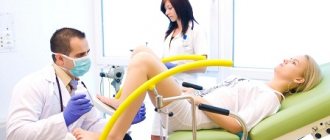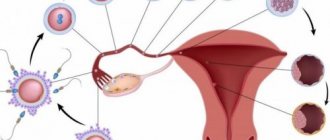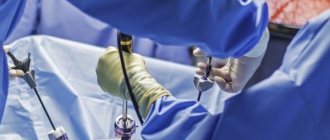Why women should visit a mammologist
About 50,000 cases of breast cancer are registered in Russia every year. Factors predisposing to the development of breast cancer include:
- complicated gynecological history: abortion, pelvic inflammatory disease,
- genetic predisposition,
- endocrine disorders: obesity, diabetes;
- chronic diseases: hypertension, atherosclerosis, kidney disease, liver disease;
- carcinogenic factors: living in environmentally unfavorable areas, smoking, working with toxic poisons.
The risk of breast cancer increases after age 35, but problems are possible at an earlier age. Women often experience problems with breastfeeding, encounter inflammatory processes, cysts, and benign neoplasms. A preventive visit to a mammologist is necessary in the same way as visits to a gynecologist.
Regular breast examinations detect pathologies in the early stages. Timely diagnosis is important for any disease, but especially for cancer. If the tumor has not affected the surrounding tissue, it is easy to cut out, and the appearance of metastases rapidly reduces the chances of recovery.
If there are no complaints, the visit to the mammologist is repeated once every 2 years. If suspicious symptoms appear, you should consult a doctor immediately.
When should I go for an examination?
Healthy girls, starting from adolescence and women of the childbearing period, need to visit a mammologist in order to notice negative tissue changes in time.
The mammary glands are the target tissue for female sex hormones. Normally, under the influence of increased levels of these substances, the bust tissues prepare for possible pregnancy and lactation. If hormonal levels are disrupted due to stress, improper use of contraceptives, or for other reasons, the target tissue may suffer. The risk of developing mastopathy, fibroadenomas and even cancer increases.
Reasons for an urgent visit to a mammologist
Breast cancer stages 1 and 2 are often asymptomatic. A lump in the chest may not manifest itself for a long time. Therefore, women are recommended to conduct self-examination of the mammary glands after menstruation or before ovulation. You need to stand in front of the mirror and feel your chest. If a lump is detected, this is a reason to urgently visit a mammologist.
You should also see a doctor if you have the following symptoms:
- changes in the shape and size of the mammary glands, pronounced asymmetry, the appearance of edema;
- change in the shape and size of the nipples and areola;
- deformation of the chest, the appearance of dimples and depressions when raising the arms up;
- pain that occurs for no apparent reason and persists for a long time;
- pain associated with the approach of menstruation;
- bloody, purulent, serous, colostrum-like discharge from the nipples;
- changes in the skin of the mammary glands: the appearance of a lemon peel effect. increased density, ulcers, peeling, wrinkling;
- enlargement of axillary, supraclavicular, subclavian lymph nodes;
- swelling in the area of the mammary glands.
The listed symptoms are characteristic not only of malignant breast tumors. They can talk about an abscess, mastopathy, adenoma and other diseases. A visit to the doctor will allow you to establish an accurate diagnosis.
Breastfeeding women, in some cases, also require the help of a doctor. When is the best time to see a specialist without delay:
- symptoms of lactostasis and milk stagnation appeared;
- deep cracks appeared on the nipples;
- When feeding, the woman experiences severe pain.
Seeing a mammologist after completing lactation is a smart decision. The doctor examines the condition of the breast after breastfeeding.
The opinion that this doctor should be visited only after 40 years of age, and that young patients do not need him, is erroneous. Regardless of what age the symptoms appeared, you cannot delay. Breast cancer occurs in all age groups.
When is it time to contact a mammologist?
Unfortunately, breast cancer is the most common cancer pathology in women. According to sad statistics, in Russia every tenth representative of the fairer sex falls ill with it. Therefore, we decided to seek advice from mammologist Alla Kartasheva, host of the program “10 Solutions of Dr. Kartasheva” on the “Doctor” TV channel.
A mammologist is a specialist who diagnoses breast diseases. As a rule, mammologists have a primary specialization in oncology or gynecology, and less often in radiation diagnostics.
Examination of the mammary glands begins in girls and young women from the moment menstruation occurs and the mammary glands begin to grow and respond to hormonal changes in the body. Since I am an adult doctor, patients come to me from the age of 18.
As a rule, the main complaints in young patients are pain in the second half of the menstrual cycle, asymmetry, and discharge from the ducts. Girls may also experience discomfort or feel lumps.
We, mammologists, prefer to conduct examinations from the 5th to the 12th day from the start of the menstrual cycle.
During this period, the breast is less painful during examination, less swollen, and if a puncture biopsy is necessary, the diagnostic result is most reliable.
Basic diagnostic tests
When the patient is under 40 years old, the consultation is necessarily supplemented by an ultrasound of the mammary glands and regional lymph nodes. Since passport age does not always correspond to biological age, the structure of the gland has its own individual characteristics: fibro-fatty involution in young women and glandular hyperplasia (adenosis) in very mature women.
Depending on what is seen on the ultrasound, the doctor decides how informative the mammography examination will be for a given patient. If the gland is dense and additional examination is required, then it is preferable for young women to undergo MR mammography with contrast or tomosynthesis.
For women after 40 years of age, mammography is still the gold standard, and the above ultrasound, tomosynthesis, and MR mammography are performed as an addition and as needed.
It is important to emphasize that breast ultrasound, mammography and contrast-enhanced MR mammography are aimed at identifying different problems and are not mutually exclusive examination methods.
Thus, ultrasound can help distinguish a fibroadenoma from a cyst, but the accumulation of microcalcifications and a small area of tissue restructuring (the first, preclinical signs of cancer) can only be seen on mammograms.
Discharges: what do they mean?
During the examination, a mammologist can detect discharge from the ducts.
- If the discharge is cloudy, greenish or white, then this is a sign of diffuse mastopathy, a background disease and, as a rule, harmless. The doctor will take a swab impression on a glass slide to make sure there is no danger.
- If the discharge is clear, straw-yellow, brown or bloody, then this may be a sign of intraductal papillomas or malignant pathology. In this case, it is especially important to immediately visit a mammologist.
With such discharge, in addition to a smear, a special study of the ducts will be performed - ductography, and after this the doctor will decide on further tactics.
Examinations and pregnancy
It is very important to be examined by a mammologist before such an important event in life as pregnancy.
When pregnancy occurs, the breasts change, swell, swell, and against this background you can miss the onset of a serious illness. Hormonal changes during pregnancy can also affect the growth of an existing lump in the mammary gland. The same recommendations apply before starting IVF, prescribing hormonal contraceptives or hormone replacement therapy.
A few words about self-examination
Self-examination is carried out first in front of a mirror in good lighting, on the same day of the first half of the menstrual cycle.
- To begin, raise your hands and assess for any retractions or deformations of the skin.
- Then proceed to palpation. Press on the gland with your fingertips: first superficially, then with more pressure. It is better to carry out movements in a circle.
- Then apply pressure to your nipples and check your armpits.
In this way, you can independently identify changes in the mammary glands that were not there before. It should not be overestimated. With our hands, even very sensitive ones, we can detect tumors starting from 1–2 cm, while with special examination methods we detect tumors from 3 mm.
To sum it all up:
- Examination by a mammologist should begin at the age of 18–19 years. In the absence of pathology and serious oncological heredity - once a year in the first half of the menstrual cycle.
- A breast ultrasound should be performed at least once a year.
- Mammography is indicated for women over 40 years old once every one and a half to two years.
- An ultrasound or mammogram does not replace a visit to a specialist.
- Before planning a pregnancy, undergoing an IVF procedure, prescribing GC or HRT, a visit to a mammologist is required.
- If you detect discharge from the ducts, nodules in the mammary glands or other alarming symptoms, you must urgently visit a mammologist, regardless of the phase of the menstrual cycle.
Trust the specialists and don’t get sick!
Mammologist Alla Kartasheva, host of the program “10 decisions of Dr. Kartasheva” on the “Doctor” TV channel
Source: Kleo.ru
Subscribe to our channels on Yandex.Zen, , , Instagram and! Like, write comments, share with friends on social media. networks with interesting and useful materials about health and medicine!
Source: https://zen.yandex.ru/media/doc-tv.ru/kogda-pora-obrascatsia-k-mammologu-5d6d384c5eb26800ade1c6b8
What day should you make an appointment?
The mammary glands are a hormone-dependent organ. The condition of the breast is directly affected by the period of the menstrual cycle. 1 – 2 weeks before the start of menstruation, progesterone levels increase. Progesterone prepares the body for conception and breastfeeding. In the last days of the cycle, the breasts may swell, enlarge, and become painful. Therefore, you should not go to a mammologist before your period - the results of the examination and examinations will not be informative enough.
The choice of the day to go for an appointment is determined by the length of the menstrual cycle:
- if the cycle is shorter than 25 days, you need to see a doctor on days 3–5;
- if the cycle lasts 28–30 days, go for examination on days 6–12;
- if the cycle is long and exceeds 35 days, ovulation occurs late, you can visit a specialist from 10 to 18 days.
If you have an irregular cycle, you should go for an appointment immediately after your period, when the bleeding stops.
In the question of when you need to go to a mammologist, there is a fundamental point - you need to be examined before the ovulation process begins, before progesterone rises. Due to the high level of estrogen, breast tissue is soft and painless.
If a woman has reached menopause, the question of which day of the cycle to go to the mammologist is not relevant. There is no menstruation, the ovaries do not function, estrogens are steadily reduced. Therefore, you can go to the doctor any day.
During breastfeeding, periods are often absent. Therefore, you can make an appointment with a doctor for breastfeeding on any day. If a nursing woman is menstruating, you need to focus on standard recommendations about the length of the cycle.
For breast tumors there is no clear correlation with the level of tumor markers.
Why? It has been proven that two standard tumor markers, CA-125 (indicators increase in ovarian cancer) and PSA in prostate cancer in men, clearly indicate the presence of a tumor. The remaining tumor markers (CA-15-3, CEA, etc.) are within normal limits even when a malignant tumor is detected. Carrying out a study on tumor markers makes it possible to establish individual indicators and then identify their growth, that is, it is a qualitative indicator, not a quantitative one. But the information content of such a study for the mammary gland is low, in contrast to the cost. It is advisable to determine mutations in the BRCA 1-2 genes if ovarian or breast cancer is common in the family. Hereditary cancers account for no more than 8-9%.
How does an appointment with a mammologist work?
A mammologist studies and treats inflammatory, dyshormonal and tumor diseases of the mammary glands. He has a main specialty in one of three areas: gynecology, surgery, oncology.
Based on her cycle, a woman determines when it is best to go to a mammologist and makes an appointment for a consultation. During the initial visit, the doctor examines the patient’s medical history and determines the predisposition to breast cancer. He asks the following questions:
- what is the duration and regularity of the menstrual cycle;
- how many pregnancies, births and abortions there were;
- Do you have any chronic gynecological diseases?
- whether the woman is taking oral contraceptives or other hormonal medications;
- Are there any cases of breast cancer among relatives?
An examination by a mammologist includes mandatory palpation of the mammary glands and local lymph nodes in a standing and lying position. Palpation is carried out in several techniques: in a spiral, along radial lines, in upward and downward movements, in quadrants. If a specialist discovers a neoplasm, he describes in detail what it is: size, location, degree of pain, shape, consistency, degree of mobility. Since the breasts are relaxed in the first phase of the cycle, examination by a mammologist after menstruation is as painless as possible.
To get complete information about her health, a woman should undergo cancer screening. This is a complex of laboratory and instrumental examinations that make it possible to detect a malignant tumor at an early stage. As part of the cancer screening program, the doctor prescribes tests, ultrasound of the mammary glands and x-ray examination of the breast.
The following tests are required:
- general blood analysis;
- blood chemistry;
- blood test for hormone levels;
- analysis for mutations in the BRCA1, BRCA2 and CHEK2 genes.
An ultrasound examination allows you to assess the condition of local lymph nodes, and mammography shows the presence of tumors.
The examinations need to be completed quickly, so a visit to the mammologist should be planned on which day of the monthly cycle - preferably immediately after menstruation.
Examination during pregnancy, lactation and after it
It is useful for pregnant women to prepare the mammary glands in advance for breastfeeding. For this reason, it is worth visiting a mammologist, who will advise you on how to care for your bust, how to avoid congestion and other troubles.
The visit can be scheduled for any day from the moment of fertilization. There is no need to delay. If the need arises, the expectant mother will be prescribed a full breast examination to exclude pathologies, since pregnancy can cause rapid growth of a latent neoplasm.
You should definitely see a doctor after giving birth, regardless of whether the mother can breastfeed or whether she will have to use formula milk.
What diseases does a breast oncologist diagnose and treat?
Breast oncologists specialize in the diagnosis and treatment of breast cancer. This is a disease in which genetic changes occur in cells and they begin to multiply uncontrollably. When there are enough of these “wrong” cells, they form a malignant tumor.
Often, breast oncologists have to make a differential diagnosis between breast cancer and benign neoplasms, such as fibrocystic mastopathy, ductal and lobular hyperplasia, adenosis, fibroadenomas, phyllodes tumors, intraductal papilloma, fat necrosis, oil cysts, etc.
During the appointment, the doctor collects a life history, asks the woman about her complaints, when the symptoms appeared, and how they changed over time. Then the oncologist examines and palpates the mammary glands. If pathological formations are detected, the doctor prescribes an examination to understand their origin.
What tests should I go to the doctor with?
You can go to the appointment without tests if you are healthy. An examination and, if necessary, an ultrasound and mammogram are sufficient. What tests should you go to a specialist for if you experience discomfort during menstruation or feel lumps? The following results will help make a diagnosis:
- blood test for hormones: ovarian (FSH, progesterone, estradiol) and thyroid (TSH, T3, T4);
- Ultrasound of female genital organs (ovaries, uterus);
- gynecologist consultations;
- cytology of nipple discharge.
If you come to the doctor without the results of these tests, the doctor will write a referral for the necessary examinations.
With this, we say goodbye and invite you to visit our website if new questions arise about women’s “weapons” - the breasts. Share interesting information with friends using the share button via social networks.
Visits to the mammologist should be regular. This allows you to avoid many problems and promptly identify changes in the mammary glands. However, the woman cannot come to the appointment whenever she pleases. The examination by this specialist is carried out at a strictly defined time, on specially designated days. This need is due to the characteristics of the female body and the cyclic changes in the level of sex hormones.
Are you looking for a good oncologist-mammologist?
The doctors of the European Clinic are experts who have extensive experience working in the best clinics. They actively collaborate with foreign colleagues; many have undergone internships abroad.
| More information about breast cancer treatment at the European Clinic: | |
| Consultation with an oncologist-mammologist | from 5100 rub. |
| Surgeons-oncologists-mammologists | from 5100 rub. |
| Removal of a breast tumor | from 92,000 rub. |
| Emergency oncology care | from 11000 rub. |
If you need the help of an experienced oncologist, we are available 24 hours a day, 7 days a week. We know how to help.
Book a consultation 24 hours a day
+7+7+78
Conclusion
The obtained test results require mandatory interpretation by a specialist. Only a doctor will be able to determine the signs of any disease indicated by deviations in laboratory test results. Particular attention is required when analyzing women who are prone to mastopathy or cancer. Therefore, you should always inform your doctor about the presence of similar mammary gland pathologies in close relatives.
ONLINE REGISTRATION at the DIANA clinic
You can sign up by calling the toll-free phone number 8-800-707-15-60 or filling out the contact form. In this case, we will contact you ourselves.
If you find an error, please select a piece of text and press Ctrl+Enter
What is mammology? Who is a mammologist?
Mammology is a branch of medicine that deals with the diagnosis, treatment and prevention of diseases of the mammary glands. Doctors working in this field are called mammologists.
In Russia, such a specialty does not officially exist. As a rule, breast diseases are dealt with by doctors of related specialties - gynecologists, endocrinologists, surgeons, oncologists. When a Russian doctor is called a mammologist, they most often mean an oncologist.
Diseases of the mammary glands do not apply specifically to the female sex. For every 135 sick women there is 1 sick man.











